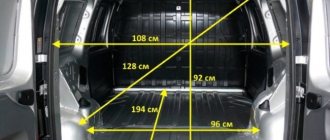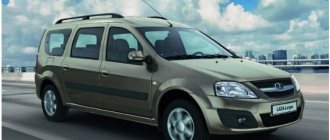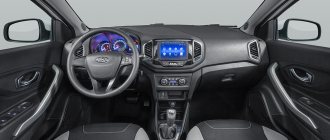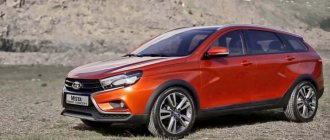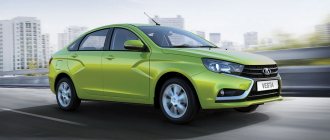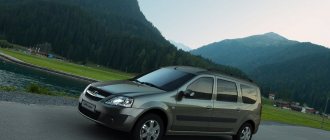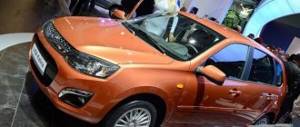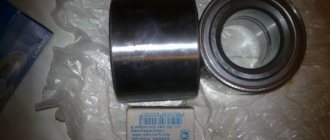The most high-profile event associated with the presentation of the concept car happened long before - in August 2012, at the Moscow International Motor Show. It was then that today's VAZ design standards in particular and the automotive industry in general were laid down.
As the Lada X-Ray was created, the developers demonstrated what they wanted to achieve and get from the new crossover; the show before the final version was the Concept 2, which was advertised in Moscow in August 2014, which was quite close to what was ultimately obtained.
Exterior of Lada XRAY
The exterior of the car is a success; it reveals the features of the previous promising Lada Vesta sedan. This crossover has all the qualities inherent in a modern car: lines of signature zigzags decorate the sides of the car, smoothly flowing into the head optics, which are framed by LED strips.
The front view of the car also adheres to the “X-style”, which is manifested by the layout of chrome-plated curving “boomerangs”, and the air intake that stretches horizontally closes it all. The large bevel of the windshield and short overhangs give the SUV dynamism and aggression.
Of course, the decision not to move the rear lights to the trunk lid allowed the manufacturer to save money, but this did not spoil the appearance of the stern at all: the rear turned out neat, without frills, and the massive plastic trim summed up the final line in the design of the car. Of course, our crossover has very modest dimensions compared to its competitors, however, the ground clearance of 195 mm and short length allow the front-wheel drive “middle peasant” to compete with all-wheel drive foreigners of the same class.
Exterior Lada X Ray
When creating the model, the task was to hide the similarity with its predecessors and “co-platforms”. This was completely successful. The car looks stylish, modern and original, while it is memorable and subsequently recognizable at first sight. Car owners like the new corporate X-style and have every chance of further continuation. You can see the details and details in the photo of the Lada X Ray.
Interior of Lada X - Rey
The interior of the Lada Xray is made in the style of minimalism: absolutely nothing superfluous and no myriads of buttons and toggle switches - everything is to the point. In the central part of the console there is an on-board computer display, which is separated by ventilation deflectors. In the middle there is a modest climate control panel, which has minimal dimensions. Instrument “wells” flash in the background of the steering wheel. The “four-spoke” steering wheel combines simplicity and convenience, and in top versions it has controls for the multimedia system.
Budget materials were used inside: the plastic lining of the dashboard is quite hard, the seats are fabric. The lateral support of the seats is quite acceptable, and the length of the cushion is “tailored” for people of average height. There is also the possibility of adjustment, which is surprisingly versatile.
In the interior of the crossover there are a lot of places where you can put a variety of small items: many pockets, retractable niches, and also a couple of cup holders. There is not much space in the back: for a tall person, the legs will rest against the rather rigid back of the chair, and the metal part of the frame protrudes unpleasantly from below and puts pressure on the ankle.
The volume of the unassembled trunk is 376 liters, but with the rear seat folded down the volume will increase by a good 1000 liters. A hidden storage compartment holds a 15-inch spare tire.
Equipment
The price category of the car starts from 589 thousand rubles. ERA-GLONASS and standard “music” are included in the basic package. The “Comfort” version will add convenience; it will cost buyers 628,000 rubles. This package includes air conditioning and heated seats, and a nice plus is the presence of a cooled glove compartment. A crossover with top-end equipment will cost 668,000 rubles, which will have rear electric windows, a multimedia system with a 7-inch diagonal display, electric drive and heated mirrors.
In general, the Xray turned out to be a solid family car; of course, it is not suitable for off-road driving, but it will serve faithfully on picnic and fishing trips.
Engine
Lada X-Ray is equipped with three four-cylinder gasoline engines that meet the Euro-5 environmental standard. The basic configuration is equipped with a 1.6-liter engine with a fuel injection system, producing 106 hp. With. and 5800 rpm. The gearbox is a five-speed manual used on Renault cars. The car accelerates to 100 in 11.9 seconds, which is quite brisk. Fuel consumption was a little disappointing: about 7.5 liters on a combined cycle for every 100 km. The middle option is the HR16DR 16-valve power unit, manufactured by the Renault-Nissan alliance. It has distributed injection and a timing drive with a chain drive.
The power of this engine is 114 hp. With. and 6000 rpm. This trim also has a five-speed manual transmission. This option is more dynamic and fast: the maximum speed is 171 km/h, and acceleration to hundreds in just 10.3 seconds. Fuel consumption is more favorable than the first: 6.9 liters on a combined cycle. And finally, the most powerful unit is a 1.8-liter engine with a capacity of 122 hp. With. at 5500 rpm. Unlike previous layouts, the gearbox here is robotic, allowing it to reach a maximum speed of 183 km/h. In terms of consumption, this engine ranks in the middle: 7.1 liters for the same cycle.
Power steering – electric. The crossover is equipped with two airbags. Many driver assistance systems are built into the “brain” of the car: ESC, BAS, EBD and ABC. The stability control system copes well with off-road conditions, making a significant contribution to overcoming difficult road conditions. The braking system is nothing extraordinary: the same drums on the rear wheels and disc brakes on the front.
Lada XRay: technical specifications
The platform for the car was taken from the Renault Sandero, which already means energy intensity, excellent handling and high ground clearance of the Lada X Rey. The bottom and the power component have changed little. The body received increased rigidity thanks to the subframe, which also performs other important functions. The suspension, body and some components have been modified. The range of engines has changed.
The model range will be represented only by the “hatchback” body type; “station wagon” and “sedan” are not provided. The body was designed with the help of Renault and Nissan using innovative digital technologies. With a common platform with other AVTOVAZ models, manufacturers tried to achieve maximum external differences and improve technical characteristics.
It is stated that the design contains about 600 original parts, which are used for the first time at VAZ. The manufacturer plans that more than 70% of components will be manufactured at Russian factories.
Dimensions of Lada X Rey
Dimensions of Lada X Rey:
- Length/width/height – 4165/1764/1570 mm.
- The wheelbase is 2592 mm.
- The front/rear wheel track size is 1484/1524 mm with R16 wheels and 1492/1532 mm with R15 wheels.
- The clearance of the Lada X Rey is 195 mm when unloaded and 170 mm at maximum load.
- The weight is distributed between the axles in the following ratio: front – 51%, rear – 49%.
- Front/rear overhangs – 830/743 mm.
- The approach/departure angles are 21/34° (without loading).
As you can see, the XRay Lada, the dimensions of which we have given above, can be classified as a front-wheel drive compact crossover.
Lada X Rey pendant
The front suspension of the Lada X Ray is independent, MacPherson type. It has significant differences from all front-wheel drive Lada models produced today. The modified suspension features levers that are attached to the subframe using silent blocks. At the end of the lever there is a ball pin. The rear suspension is a semi-independent torsion beam. This suspension is reliable and improves driving performance.
What engine does the Lada X Rey have?
The manufacturer settled on three possible engine options. All of them are gasoline and quite powerful:
- The basic VAZ-21129, which has proven itself and is widely used in other AVTOVAZ models.
- Modernization of the intake system made it possible to increase engine power from 98 hp. up to 106 hp At low speeds, air is supplied through long intake channels, and at high speeds, through short ones, which ensures a change in the composition of the fuel mixture. The engine works with a 5-speed gearbox from Renault, which is assembled at AVTOVAZ.
- Gasoline engine developed by Renault-Nissan (Nissan calls it HR16, Renault calls it H4M). The development of 2006 is widely installed on cars. The engine works in tandem with a 5-speed manual transmission from Renault.
- The modern and most powerful VAZ-21128 engine. Engine performance has been improved through a redesign aimed at increasing the piston stroke. The connecting rod and piston group from the Federal-Mogul company is used, production is carried out by a subsidiary of AVTOVAZ.
The engine is paired with a robotic automatic transmission. AMT (robot box) is a domestic development. The VAZ manual transmission was taken as the basis, and the German company ZF worked on the control electronics. The box is assembled in Tolyatti.
comparison table
Options
| VAZ-21129 | HR16 ( H4M ) _ | VAZ-21128 | |
| Volume, cubic cm | 1597 | 1598 | 1797 |
| Number of cylinders/valves | 4/16 | 4/16 | 4/16 |
| Timing drive | belt | chain | belt |
| Cylinder diameter/piston stroke, mm | 82/75,6 | 78/83,6 | 82/84 |
| Power hp/kW | 106/78 | 110/81 | 122/90 |
| Torque, Nm | 148 | 156 | 173 |
| Maximum speed, km/h | 170 | 171 | 182 |
| Dynamics of acceleration to 100 km/h, sec | 11.9 | 10,3 | 10,2 |
| Fuel consumption per 100 km (city/combined cycle/highway), l | 8,5/7,3/5,7 | n/a | 8,8/7,4/5,9 |
Other technical specifications
- The braking system consists of ventilated front disc brakes and rear drum brakes. The use of ventilation makes the braking system significantly more reliable.
- Steering. Electric power steering available. The steering rack is attached to the subframe. It is possible to adjust the steering column in tilt and reach.
- The dimensions of the luggage compartment are 361 liters, with the rear seats folded - 1207 liters, with the rear and front passenger seats folded - 1514 liters.
- Gas tank capacity 50 l.
As you can see, the technical characteristics of the car make it quite competitive in the market and in demand among car owners. Many people are concerned about the question: is the body galvanized? This is an important aspect, so we hasten to reassure you that the body is completely galvanized, which significantly increases corrosion resistance.

